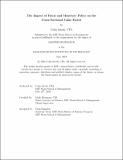| dc.contributor.advisor | Kritzman, Mark | |
| dc.contributor.author | Suvak, Colin | |
| dc.date.accessioned | 2023-07-31T19:37:05Z | |
| dc.date.available | 2023-07-31T19:37:05Z | |
| dc.date.issued | 2023-06 | |
| dc.date.submitted | 2023-07-14T20:00:15.394Z | |
| dc.identifier.uri | https://hdl.handle.net/1721.1/151403 | |
| dc.description.abstract | I find strong evidence that the cross-sectional value factor's returns are impacted by fiscal and monetary policy in the post-Bretton Woods era. Using a custom set of 768 value factors formed on the intersection of five portfolio construction design choices, which I take to represent the concept of the "value" premium in aggregate, I find that both structural and revaluation returns to the factor are lower than average during periods when fiscal and monetary policy are jointly loose. Oppositely, when each policy is tight, total and decomposed returns to value are all higher than average. My findings provide an explanation for at least part of the time-varying nature of value's returns. Factor timing strategies that tactically utilize the information contained in fiscal and monetary policy weakly improve on strategic allocations to value over the long-run. | |
| dc.publisher | Massachusetts Institute of Technology | |
| dc.rights | In Copyright - Educational Use Permitted | |
| dc.rights | Copyright retained by author(s) | |
| dc.rights.uri | https://rightsstatements.org/page/InC-EDU/1.0/ | |
| dc.title | The Impact of Fiscal and Monetary Policy on the Cross-Sectional Value Factor | |
| dc.type | Thesis | |
| dc.description.degree | M.Fin. | |
| dc.contributor.department | Sloan School of Management | |
| mit.thesis.degree | Master | |
| thesis.degree.name | Master of Finance | |
